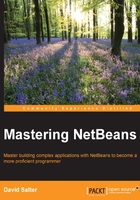
Conventions
In this book, you will find a number of text styles that distinguish between different kinds of information. Here are some examples of these styles and an explanation of their meaning.
Code words in text, database table names, folder names, filenames, file extensions, pathnames, dummy URLs, user input, and Twitter handles are shown as follows: "From there, double-click on the included NetBeans xxx.mpkg file to start the installation (the exact names of the .dmg and .mpkg files varies, depending upon the version and bundle downloaded)."
A block of code is set as follows:
public class Main {
public static void main(String args[]) {
Greeter greeter = new Greeter();
System.out.println(greeter.greet("David"));
}
}
When we wish to draw your attention to a particular part of a code block, the relevant lines or items are set in bold:
<#assign licenseFirst = "/*">
<#assign licensePrefix = " * ">
<#assign licenseLast = " */">
<#include "${project.licensePath}">
<#if package?? && package != "">
package ${package};
</#if>
/**
* Project: ${project.name}
* ${url}
*
* @author ${user}
*/
public class ${name} {
}
Any command-line input or output is written as follows:
chmod +x netbeans-<xxx>-linux.sh
New terms and important words are shown in bold. Words that you see on the screen, for example, in menus or dialog boxes, appear in the text like this: "From here, we can customize NetBeans by clicking on the Customize button."